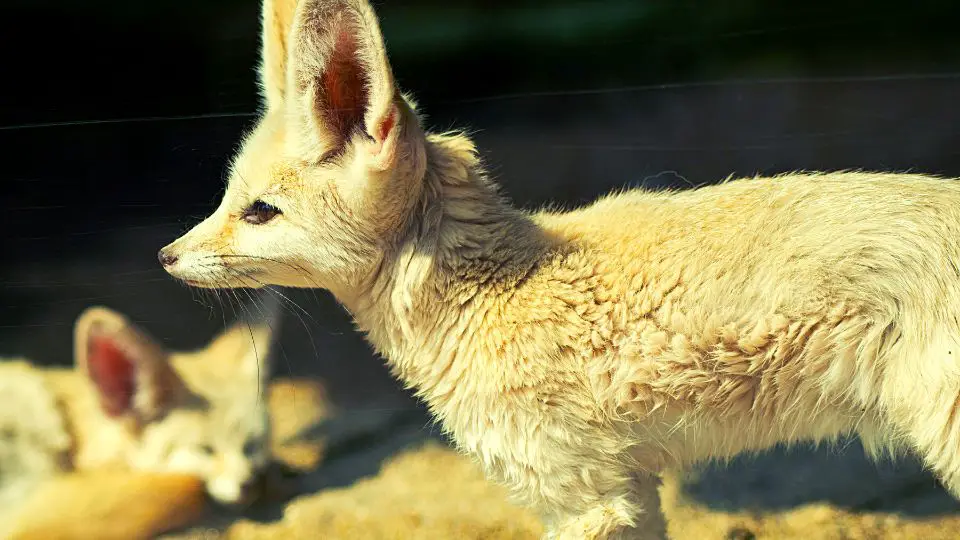Fennec foxes are fascinating animals with unique biology and behavior. If you’re thinking about owning a fennec fox or are just curious about these amazing animals, this article is for you!
We will explore the biology and behavior of fennec foxes, providing you with the information you need to understand these fascinating creatures.
From their physical characteristics to their social behavior and communication, we’ll cover it all. So, let’s get started and dive into the amazing world of fennec foxes!
Fennec Fox Biology
Fennec foxes are small animals, with a head-and-body length of just 16 to 18 inches (ca. 46 cm) and a weight of 2.2 to 3.3 lbs (1 to 1.5 kg). They have large, pointed ears that range from 3.6 to 6 inches (ca. 15 cm) in length, which help them locate prey and dissipate heat.
Fennec foxes are known for their unique appearance and distinctive features that set them apart from other species of foxes. Understanding their physical characteristics is essential to appreciating these fascinating creatures and providing proper care for them.
Physical Characteristics
Fur and Coloration
One of the most notable characteristics of fennec foxes is their thick, soft fur, which helps to insulate them from the extreme heat of their desert habitat. The fur is typically a light sandy color, although it may range from cream to yellowish-brown.
Their fur also helps to reflect sunlight, reducing their body temperature. In addition to being soft and plush, the fur of a fennec fox is also thick and dense, providing them with excellent protection from the elements.
Ears
Fennec foxe’s ears are proportionally much larger than those of any other species of fox, and they play a crucial role in regulating their body temperature. The large surface area of the ears helps to dissipate heat and reduce the amount of body heat absorbed from the sun.
The ears are also highly mobile, allowing the fennec fox to detect and locate prey, as well as to communicate with other members of their species.
Sensory Adaptations
Vision
Fennec foxes have excellent night vision, which is an adaptation to their nocturnal lifestyle. They have large eyes and a reflective layer in their eyes that helps to amplify light, allowing them to see in the dark.
Hearing
Fennec foxes have exceptional hearing, which is essential for locating their prey and avoiding danger in the desert environment. Their large ears allow them to pick up on even the slightest sounds, and they are able to adjust the position of their ears to focus on specific sounds.
Smell
Fennec foxes have a keen sense of smell, which is used to locate food and detect potential predators. Their sense of smell is particularly important in the desert environment, where food can be scarce and predators are constantly a threat.
Anatomy and Physiology
Reproductive system
Fennec foxes typically reach sexual maturity at around 8 months of age. During the breeding season, which usually occurs between January and March, the female will give birth to litters of 2 to 4 kits. The gestation period is around 51 to 53 days.
Digestive system
Fennec foxes are opportunistic feeders and will eat a variety of food items, including insects, small mammals, birds, and vegetation. They have a relatively simple digestive system, which is well-suited to processing their diverse diet.
The intestines are short, to minimize the amount of water lost through digestion, and the feces are dry and compact, making it easier to conserve water.
Respiratory system
The fennec fox’s respiratory system is adapted to the hot and dry desert environment in which it lives. The nose is highly vascularized, which helps to cool the blood as it passes through and reduces the risk of overheating. The fox’s panting behavior helps to regulate its body temperature by dissipating heat.
Habitat and Distribution
Natural habitat
Fennec foxes are native to the deserts of North Africa, where they burrow in the sand to escape the extreme heat and to avoid predators. Their dens are typically located near sources of food and water, such as desert oasis and underground water sources.
In their natural habitat, fennec foxes feed primarily on insects and small mammals, as well as small reptiles and birds.
Range
Fennec foxes are found in a limited range that includes parts of Morocco, Algeria, Tunisia, Libya, and Egypt. Their range has been reduced in recent years due to habitat loss and other threats, but they remain a widespread species that is relatively common within their range.
Despite the challenges they face in their natural habitat, fennec foxes are hardy animals that have been able to adapt to life in the desert and are able to survive in the harsh conditions of the Sahara.
Fennec Fox Behavior
Fennec foxes are primarily nocturnal, and they prefer to stay in their burrows during the day when it is hot. At night, they come out to search for food and socialize. They are curious and friendly animals, and they often seek out contact with humans.
Social Structure and Communication
Group behavior
Fennec foxes do not form social groups like some other species of foxes, but they will tolerate the presence of other fennecs within their territory.
Fennecs are territorial animals and will mark their territory using urine, feces, and scent marking. They will also defend their territory against other fennecs if necessary.
Despite their solitary nature, fennec foxes are not shy animals. They are quite curious and are not easily intimidated by humans or other animals. They are known for their playful and energetic nature and will often engage in play behavior with each other.
Vocalizations
Fennecs have a range of vocalizations, including barks, growls, and whines, which they use to express a variety of emotions and to communicate with other members of their species. They are also capable of producing high-pitched “screams” to ward off potential predators.
Fennecs also communicate through body language, including facial expressions and postures. When threatened or agitated, they will arch their backs and fluff up their fur to appear larger.
Foraging and Hunting
Diet and feeding habits
Fennecs diet consists primarily of small insects, but they are also known to eat small mammals, reptiles, and plants. In the wild, fennec foxes are opportunistic feeders, meaning they will take advantage of whatever food sources are available to them.
They have sharp, retractable claws that allow them to dig into the sand and uncover insects, as well as large, sensitive ears that can detect the movements of their prey even from a distance. Their keen sense of smell also helps them locate food.
Hunting behavior
When hunting, fennec foxes are solitary animals, relying on their stealth and agility to catch their prey. They are known to use their large ears to detect the movements of insects, and to use their sharp claws to dig into the sand and uncover them. Once they have located their prey, they use their quick reflexes to capture it in their mouth.
Fennec foxes are considered to be among the most efficient predators in their desert habitat, and their ability to locate and capture food is a critical factor in their survival. By understanding their foraging and hunting behavior, we can gain a greater appreciation for the remarkable adaptations that have enabled these animals to thrive in one of the harshest environments on earth.
Reproduction and Family Life
Fennec foxes are monogamous animals that mate for life, with males competing for females during the breeding season. Once a pair has bonded, they will mate, and the female will give birth to a litter of pups. Both parents play an active role in raising and caring for the offspring, with the mother nursing and the father helping to keep the pups warm and bringing food.
Mating and breeding
Fennec foxes are monogamous animals, meaning that they mate for life. During breeding season, which occurs between January and February in the wild, male fennec foxes will compete for the attention of females by marking their territory and engaging in vocalizations to attract a mate. Once a pair has bonded, they will mate and the female will give birth to a litter of pups.
In captivity, it’s important to ensure that a suitable mate is selected for the fox. Fennec foxes that are not paired with a suitable mate may become aggressive or stressed, so it’s essential to ensure that the pair is compatible. It’s also crucial to provide a safe and suitable breeding environment for the foxes, as they can be easily stressed by changes in their environment.
Parenting and offspring care
Once the female fennec fox gives birth, both parents play an active role in raising and caring for the offspring. The mother typically nurses the pups for the first few weeks of their lives and remains close to them at all times, ensuring that they are well-fed and cared, while the father helps keeping them warm and bringing food to the den.
Fennec fox pups are born with their eyes closed, and they will remain in the den with their parents for the first few weeks of their lives. As they grow older, they will become more active and begin to explore their environment. At around 6 weeks old, the pups will start to eat solid food, and the mother will begin to wean them.
It’s important to note that fennec foxes are not domesticated animals, and while they may make good pets for some people, they require specialized care and attention.
Sleep and Activity Cycle
Fennec foxes are desert animals, and they have unique sleep and activity patterns that are well-adapted to their arid environment. In captivity, it’s essential to understand these patterns to ensure that your fennec fox gets the rest and activity it needs to stay healthy and happy.
Sleep patterns
Fennec foxes are primarily nocturnal animals, meaning that they are most active at night. During the day, they will typically sleep in their dens, where they feel safe and secure. In captivity, you can provide a suitable sleeping environment for your fennec fox by providing a dark and quiet den or crate where they can sleep during the day.
It’s important to note that fennec foxes may also take short naps throughout the day, especially during the cooler seasons when they are more active during the daytime. So you have to provide a sleeping area that remains quiet and undisturbed to ensure that they can rest well.
Daily activity patterns
Fennec foxes are most active during the nighttime hours, and they will typically spend this time exploring their environment, hunting, and playing. In captivity, you can provide a suitable activity area for your fennec fox by creating an enclosure that has plenty of space to run, play, and climb.
During the daytime, fennec foxes may be less active and prefer to rest in their dens. However, providing enrichment activities such as toys, tunnels, and puzzles can help keep them active and engaged during the day.
Conclusion
In conclusion, fennec foxes are fascinating animals that have unique behavior and needs. Understanding their sleep and activity patterns, as well as providing a suitable mate, breeding environment, and a stimulating area for play and exploration is essential to ensure that they can thrive both in the wild and in captivity. With proper care and attention, fennec foxes can live long, happy lives.







